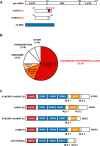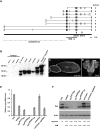Drosophila Syncrip binds the gurken mRNA localisation signal and regulates localised transcripts during axis specification
- PMID: 23213441
- PMCID: PMC3507208
- DOI: 10.1242/bio.2012885
Drosophila Syncrip binds the gurken mRNA localisation signal and regulates localised transcripts during axis specification
Abstract
In the Drosophila oocyte, mRNA transport and localised translation play a fundamental role in axis determination and germline formation of the future embryo. gurken mRNA encodes a secreted TGF-α signal that specifies dorsal structures, and is localised to the dorso-anterior corner of the oocyte via a cis-acting 64 nucleotide gurken localisation signal. Using GRNA chromatography, we characterised the biochemical composition of the ribonucleoprotein complexes that form around the gurken mRNA localisation signal in the oocyte. We identified a number of the factors already known to be involved in gurken localisation and translational regulation, such as Squid and Imp, in addition to a number of factors with known links to mRNA localisation, such as Me31B and Exu. We also identified previously uncharacterised Drosophila proteins, including the fly homologue of mammalian SYNCRIP/hnRNPQ, a component of RNA transport granules in the dendrites of mammalian hippocampal neurons. We show that Drosophila Syncrip binds specifically to gurken and oskar, but not bicoid transcripts. The loss-of-function and overexpression phenotypes of syncrip in Drosophila egg chambers show that the protein is required for correct grk and osk mRNA localisation and translational regulation. We conclude that Drosophila Syncrip is a new factor required for localisation and translational regulation of oskar and gurken mRNA in the oocyte. We propose that Syncrip/SYNCRIP is part of a conserved complex associated with localised transcripts and required for their correct translational regulation in flies and mammals.
Keywords: Drosophila; Syncrip; localised translation; mRNA localization; oogenesis.
Conflict of interest statement
Figures






Similar articles
-
The mago nashi gene is required for the polarisation of the oocyte and the formation of perpendicular axes in Drosophila.Curr Biol. 1997 Jul 1;7(7):468-78. doi: 10.1016/s0960-9822(06)00218-1. Curr Biol. 1997. PMID: 9210377
-
Translational repression of gurken mRNA in the Drosophila oocyte requires the hnRNP Squid in the nurse cells.Dev Biol. 2009 Feb 15;326(2):327-34. doi: 10.1016/j.ydbio.2008.11.030. Epub 2008 Dec 7. Dev Biol. 2009. PMID: 19100729
-
Bruno regulates gurken during Drosophila oogenesis.Mech Dev. 2003 Mar;120(3):289-97. doi: 10.1016/s0925-4773(02)00454-9. Mech Dev. 2003. PMID: 12591598
-
mRNA localisation during development.Dev Biol. 1995 Dec;172(2):377-95. doi: 10.1006/dbio.1995.8048. Dev Biol. 1995. PMID: 8612958 Review.
-
Axis formation during Drosophila oogenesis.Curr Opin Genet Dev. 2001 Aug;11(4):374-83. doi: 10.1016/s0959-437x(00)00207-0. Curr Opin Genet Dev. 2001. PMID: 11448623 Review.
Cited by
-
SYNCRIP facilitates porcine parvovirus viral DNA replication through the alternative splicing of NS1 mRNA to promote NS2 mRNA formation.Vet Res. 2021 May 25;52(1):73. doi: 10.1186/s13567-021-00938-6. Vet Res. 2021. PMID: 34034820 Free PMC article.
-
Community effects in regulation of translation.Elife. 2016 Apr 22;5:e10965. doi: 10.7554/eLife.10965. Elife. 2016. PMID: 27104756 Free PMC article.
-
Microtubule and Actin Cytoskeletal Dynamics in Male Meiotic Cells of Drosophila melanogaster.Cells. 2022 Feb 16;11(4):695. doi: 10.3390/cells11040695. Cells. 2022. PMID: 35203341 Free PMC article. Review.
-
Genetic screen identifies a requirement for SMN in mRNA localisation within the Drosophila oocyte.BMC Res Notes. 2018 Jun 13;11(1):378. doi: 10.1186/s13104-018-3496-1. BMC Res Notes. 2018. PMID: 29895323 Free PMC article.
-
Identification of RNA-binding proteins that partner with Lin28a to regulate Dnmt3a expression.Sci Rep. 2021 Jan 27;11(1):2345. doi: 10.1038/s41598-021-81429-8. Sci Rep. 2021. PMID: 33504840 Free PMC article.
References
-
- Bannai H., Fukatsu K., Mizutani A., Natsume T., Iemura S., Ikegami T., Inoue T., Mikoshiba K. (2004). An RNA-interacting protein, SYNCRIP (heterogeneous nuclear ribonuclear protein Q1/NSAP1) is a component of mRNA granule transported with inositol 1,4,5-trisphosphate receptor type 1 mRNA in neuronal dendrites. J. Biol. Chem. 279, 53427–53434 10.1074/jbc.M409732200 - DOI - PubMed
-
- Barbee S. A., Estes P. S., Cziko A. M., Hillebrand J., Luedeman R. A., Coller J. M., Johnson N., Howlett I. C., Geng C., Ueda R. et al. (2006). Staufen- and FMRP-containing neuronal RNPs are structurally and functionally related to somatic P bodies. Neuron 52, 997–1009 10.1016/j.neuron.2006.10.028 - DOI - PMC - PubMed
Grants and funding
LinkOut - more resources
Full Text Sources
Molecular Biology Databases

